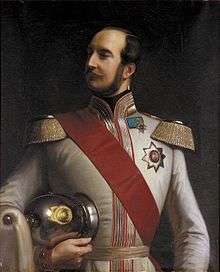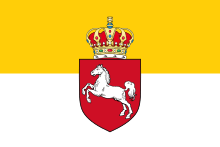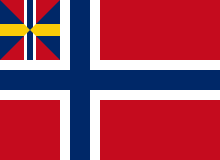George V of Hanover
George V (Georg Friedrich Alexander Karl Ernst August; 27 May 1819 – 12 June 1878) was the last King of Hanover, the only child and successor of King Ernest Augustus. George V's reign ended during the unification of Germany.
| George V | |||||
|---|---|---|---|---|---|
 | |||||
| King of Hanover | |||||
| Reign | 18 November 1851 – 20 September 1866 | ||||
| Predecessor | Ernest Augustus | ||||
| Born | 27 May 1819 Berlin, Prussia | ||||
| Died | 12 June 1878 (aged 59) Paris, France | ||||
| Burial | 24 June 1878 St George's Chapel, Windsor | ||||
| Consort | Marie of Saxe-Altenburg | ||||
| Issue | Ernest Augustus, Crown Prince of Hanover Princess Frederica of Hanover Princess Marie of Hanover | ||||
| |||||
| House | Hanover | ||||
| Father | Ernest Augustus, King of Hanover | ||||
| Mother | Frederica of Mecklenburg-Strelitz | ||||
| Signature | |||||
Early life
Prince George of Cumberland was born on 27 May 1819 in Berlin, the only son of Prince Ernest Augustus, Duke of Cumberland. Ernest Augustus was the fifth son of George III of the United Kingdom and his wife, Charlotte of Mecklenburg-Strelitz.
He was baptized on 8 July 1819 at a hotel in Berlin where his parents were staying, by the Rev. Henry Thomas Austen (brother of author Jane Austen). His godparents were the then Prince Regent (George IV of the United Kingdom, represented by the Duke of Cumberland), King Frederick William III of Prussia, Emperor Alexander I of Russia, the Crown Prince of Prussia Frederick William IV of Prussia, Prince William of Prussia, Prince Frederick of Prussia, Prince Henry of Prussia, Prince Wilhelm of Prussia, the Grand Duke Georg of Mecklenburg-Strelitz, Duke Charles of Mecklenburg, Empress Maria Feodorovna, the Queen of the Netherlands Wilhelmine of Prussia, the Princess Augusta Sophia of the United Kingdom, the Hereditary Princess of Hesse-Homburg Princess Elizabeth of the United Kingdom, the Princess Mary (Duchess of Gloucester and Edinburgh), Princess Sophia of the United Kingdom, Princess Alexandrine of Prussia, the Electoral Princess Augusta of Hesse-Kassel, the Duchess of Anhalt-Dessau Princess Frederica Wilhelmina of Prussia, Princess Maria Anna of Hesse-Homburg (Princess William of Prussia), Margravine Elisabeth Louise of Brandenburg-Schwedt (Princess Ferdinand of Prussia), Princess Louisa of Prussia (Princess Louise of Prussia (1808-1870)) and Princess Radziwill (Princess Louise of Prussia (1770-1836)).[1]
George spent his childhood in Berlin and in Great Britain. He lost the sight of one eye following a childhood illness in 1828,[2] and in the other eye following an accident in 1833.[3] His father had hoped that the young prince might marry his cousin Queen Victoria, who was older by three days, thus keeping the British and Hanoverian thrones united, but nothing ever came of the plan.
Crown Prince
Upon the death of King William IV and the accession of Queen Victoria to the British throne, the 123-year personal union of the British and Hanoverian thrones ended because Hanover's semi-Salic law prevented a woman from ascending its throne. The Duke of Cumberland succeeded to the Hanoverian throne as Ernst August, and Prince George became the Crown Prince of Hanover. As a legitimate descendant of George III in the male line, he remained a member of the British royal family and second in line to the British throne until the birth of Queen Victoria's first child, Victoria, Princess Royal, in 1840. Since he was totally blind, there were doubts as to whether the Crown Prince was qualified to succeed as king of Hanover, but his father decided that he should do so.[4]


Marriage
George married, on 18 February 1843, at Hanover, Princess Marie of Saxe-Altenburg, the eldest daughter of Joseph, Duke of Saxe-Altenburg, by his wife, Duchess Amelia of Württemberg.
King of Hanover
_Hanoverian_Medal%2C_obverse.jpg)
The Crown Prince succeeded his father as the King of Hanover and Duke of Brunswick-Lüneburg as well as Duke of Cumberland and Teviotdale, in the Peerage of Great Britain and Earl of Armagh, in the Peerage of Ireland, on 18 November 1851, assuming the style George V.[5]
From his father and from his maternal uncle, Prince Charles Frederick of Mecklenburg-Strelitz, one of the most influential men at the Prussian court, George had learned to take a very high and autocratic view of royal authority. During his 15-year reign, he engaged in frequent disputes with the Hanoverian Landtag (parliament).
George was generally supportive of Austria in the Diet of the German Confederation. As the Austro-Prussian War started, the Prussian government sent a dispatch on 15 June 1866 demanding that Hanoverian troops submit to their authority or face war.[6] Despite previously having concluded that Hanover could not win an armed confrontation with Prussia, George remained protective of his throne and refused the ultimatum.[7] Contrary to the wishes of the parliament, Hanover joined the Austrian camp in the war. As a result, the Prussian army occupied Hanover and the Hanoverian army surrendered on 29 June 1866 following the Battle of Langensalza, the King and royal family having fled to Austria. The Prussian government formally annexed Hanover on 20 September 1866, despite the King of Prussia, William I, being a first cousin of King George V of Hanover; their mothers were sisters. The deposed King never renounced his rights to the throne or acknowledged Prussia's actions. From exile in Gmunden, Austria, he appealed in vain for the European great powers to intervene on behalf of Hanover. From 1866 to 1870, George V maintained the Guelphic Legion partially at his own expense.[8]
While in exile from his throne, he was appointed an honorary full general in the British army in 1876.[9]
Death
George V died at his residence in the Rue de Presbourg, Paris, on 12 June 1878. After a funeral service in the Lutheran Church at the Rue Chaucat,[9] his body was removed to England and buried in St George's Chapel at Windsor Castle.[5][10][11]
Legacy
The King supported industrial development. In 1856 the "Georgs-Marien-Bergwerks- und Hüttenverein" was founded which was named after him and his wife. The company erected an iron and steel works which gave the city Georgsmarienhütte its name.[12]
Titles, styles and arms
Titles and styles
- 27 May 1819 – 20 June 1837: His Royal Highness Prince George of Cumberland, Prince of Hanover
- 20 June 1837 – 18 November 1851: His Royal Highness The Crown Prince of Hanover, Prince of Great Britain and Ireland
- 18 November 1851 – 12 June 1878: His Majesty The King of Hanover
Arms
By grant dated 15 August 1835, George's arms in right of the United Kingdom were those of his father (being the arms of the United Kingdom, differenced by a label argent of three points, the centre point charged with a fleur-de-lys azure, and each of the other points charged with a cross gules), the whole differenced by a label gules bearing a horse courant argent.[13]
Honours

- Grand Cross of the Royal Guelphic Order, 1825[9]
- Knight of St. George, 1839[14]
- Founder of the Order of Ernst August, 15 December 1865


- Grand Cross of St. Stephen, 1843
- Commander of the Military Order of Maria Theresa, 1866
.svg.png)
- Knight of the House Order of Fidelity, 1855
- Grand Cross of the Zähringer Lion, 1855
.svg.png)

.svg.png)

.svg.png)
.svg.png)
.svg.png)
.svg.png)


.svg.png)
.svg.png)
.svg.png)
.svg.png)
.svg.png)


Ancestry
| Ancestors of George V of Hanover |
|---|
Issue
| Name | Birth | Death | Notes |
|---|---|---|---|
| Ernest Augustus, Crown Prince of Hanover | 21 September 1845 | 14 November 1923 | Ernest Augustus William Adolphus George Frederick; born at Hanover, died at Gmunden, married Princess Thyra of Denmark; had issue |
| Princess Frederica of Hanover | 9 January 1848 | 16 October 1926 | born at Hanover, died at Biarritz; married Alfons, Baron von Pawel-Rammingen; had no surviving issue |
| Princess Marie of Hanover | 3 December 1849 | 4 June 1904 | Marie Ernestine Josephine Adolphine Henrietta Theresa Elizabeth Alexandrina; born at Hanover, died unmarried at Gmunden |
References
- "No. 17497". The London Gazette. 24 July 1819. p. 1296.
- William Christian Sellé, letter to The Times dated 3 July
- Letter to the Times dated 5 July by William Christian Sellé
- The Encyclopaedia Britannica: A Dictionary of Arts, Sciences, Literature and General Information, Volume 11. Encyclopaedia Britannica. 1910.
- Weir, Alison (18 April 2011). "The House of Hanover". Britain's Royal Families: The Complete Genealogy. Random House. p. 291.
- Heinzen, Jasper. The Guelph 'Conspiracy': Hanover as Would-Be Intermediary in the European System, 1866–1870. The International History Review 29, No. 2 (2007), pp. 258–281.
- Schmitt, Hans A. Prussia's Last Fling: The Annexation of Hanover, Hesse, Frankfurt, and Nassau, 15 June – 8 October 1866. Central European History 8, No. 4 (1975), pp. 316–347.
- Schmitt, Hans A. Prussia's Last Fling: The Annexation of Hanover, Hesse, Frankfurt, and Nassau, 15 June – 8 October 1866. Central European History 8, No. 4 (1975), pp. 316–347.
- The Complete Peerage, Volume III. St Catherine Press. 1913. p. 576. Under "Duke of Cumberland".
- Boase, Frederic Boase (1892). Modern English Biography: A-H. Netherton and Worth. p. 1821.
- "Royal Burials in the Chapel since 1805". College of St. George. Archived from the original on 2 August 2017.
- Gieseler, Albert. "Georgsmarien-Hütten- und Bergwerksverein". Kraft- und Dampfmaschinen (in German). Retrieved 23 October 2017.
- Marks of Cadency in the British Royal Family
- Hof- und Staats-Handbuch des Königreich Hannover (1847), "Königliche Orden und Ehrenzeichen" p. 36
- Shaw, Wm. A. (1906) The Knights of England, I, London, p. 55
- "Ritter-Orden", Hof- und Staatshandbuch der Österreichisch-Ungarischen Monarchie, 1877, pp. 59, 62, retrieved 2 November 2019
- Hof- und Staats-Handbuch des Großherzogtum Baden (1873), "Großherzogliche Orden" pp. 59, 73
- Hof- und Staats-Handbuch des Königreichs Bayern (in German). Königl. Oberpostamt. 1867. p. 8. Retrieved 15 July 2019.
- Braunschweigisches Adreßbuch für das Jahr 1866. Braunschweig 1866. Meyer. p. 4
- Le livre d'or de l'ordre de Léopold et de la croix de fer, Volume 1 /Ferdinand Veldekens
- Jørgen Pedersen (2009). Riddere af Elefantordenen, 1559–2009 (in Danish). Syddansk Universitetsforlag. p. 464. ISBN 978-87-7674-434-2.
- Staatshandbücher für das Herzogtum Sachsen-Coburg und Gotha (1843), "Herzogliche Sachsen-Ernestinischer Hausorden" p. 6
- M. & B. Wattel (2009). Les Grand'Croix de la Légion d'honneur de 1805 à nos jours. Titulaires français et étrangers. Paris: Archives & Culture. p. 469. ISBN 978-2-35077-135-9.
- Daniel Corston. "Unofficial website dedicated to the Grand Ducal House of Mecklenburg-Strelitz". mecklenburg-strelitz.org.
- Hof- und Staatshandbuch des Großherzogtums Oldenburg: für das Jahr 1872/73, "Der Großherzogliche Haus-und Verdienst Orden" p. 29
- Liste der Ritter des Königlich Preußischen Hohen Ordens vom Schwarzen Adler (1851), "Von Seiner Majestät dem Könige Friedrich Wilhelm III. ernannte Ritter" p. 20
- Staatshandbuch für das Großherzogtum Sachsen / Sachsen-Weimar-Eisenach (1859), "Großherzogliche Hausorden" p. 13
- Staatshandbuch für den Freistaat Sachsen (1867) (in German), "Königliche Ritter-Orden", p. 4
- "Caballeros de la insigne orden del toisón de oro", Guía Oficial de España (in Spanish), 1868, p. 157, retrieved 10 December 2019
- Sveriges och Norges statskalender. Liberförlag. 1874. p. 468.
- Hof- und Staats-Handbuch des Königreich Württemberg (1873), "Königliche Orden" p. 31
External links
| Wikimedia Commons has media related to Georg V of Hannover. |
- Die Welfen – George V (with portrait) (in German)
|-
George V of Hanover Cadet branch of the House of Welf Born: 27 May 1819 Died: 12 June 1878 | ||
| Regnal titles | ||
|---|---|---|
| Preceded by Ernest Augustus |
King of Hanover 18 November 1851 – 20 September 1866 |
Office abolished |
| Peerage of Great Britain | ||
| Preceded by Ernest Augustus |
Duke of Cumberland and Teviotdale 18 November 1851 – 12 June 1878 |
Succeeded by Ernest Augustus |
| Titles in pretence | ||
| Loss of title |
— TITULAR — King of Hanover 20 September 1866 – 12 June 1878 |
Succeeded by Ernest Augustus |
.svg.png)
.svg.png)
